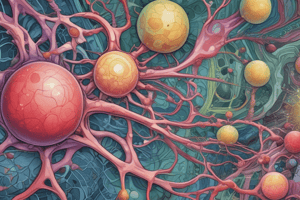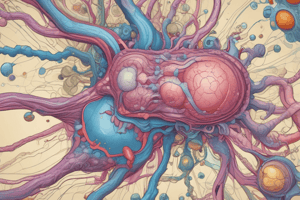Podcast
Questions and Answers
What are the three types of muscle cells in the human body?
What are the three types of muscle cells in the human body?
Skeletal, cardiac, and smooth muscle
What is characteristic of skeletal and cardiac muscle cells?
What is characteristic of skeletal and cardiac muscle cells?
They are striated, with aligned arrangement of myosin and actin proteins
What is the main function of muscle tissue?
What is the main function of muscle tissue?
Movement of the body
What is the main component of fat cells?
What is the main component of fat cells?
What is the shape of the nucleus in fat cells?
What is the shape of the nucleus in fat cells?
What is the average diameter of white fat cells?
What is the average diameter of white fat cells?
What are the main components of the fat inside white fat cells?
What are the main components of the fat inside white fat cells?
What is the main characteristic of male sex cells?
What is the main characteristic of male sex cells?
How do gametes reproduce?
How do gametes reproduce?
What is the result of fertilization in sexual reproduction?
What is the result of fertilization in sexual reproduction?
Flashcards are hidden until you start studying
Study Notes
Types of Animal Cells
- The cell is the basic unit of life, and there are hundreds of different types of cells in the body.
Stem Cells
- Stem cells can differentiate into other types of cells and can also divide in self-renewal to produce more of the same type of stem cells.
Red Blood Cells (Erythrocytes)
- Shaped like a biconcave disc (donut-shaped)
- Fairly flexible, allowing them to squeeze through thin blood capillaries
- Lack a nucleus and cytoplasmic organelles
- Uniform in size, can be used as a size reference for other cell types
- Stain pink with eosin
- Main roles: transport oxygen, help control pH, and release carbonic anhydrase
Frog Red Blood Cells
- Oval shape with a nucleus inside each RBC
White Blood Cells (Leukocytes)
- Vital component of the immune system
- Larger than RBCs
- Nucleated with spherical or kidney-shaped or lobed nucleus
- Five different types: granulocytes (Neutrophils, Eosinophils, and Basophils) and agranulocytes (Lymphocytes and Monocytes)
Platelets
- Fragments of megakaryocytes produced in the bone marrow
- Have surface proteins that allow them to bind to one another and to damaged blood vessel walls
- Recruit when bleeding occurs, initiating hemostasis and forming a blood clot with fibrin
Epithelial Cells
- Specialized to stick tightly to one another
- Line the interior of hollow organs or cover surfaces like the skin
- Three shapes: flat (squamous), cube-shaped (cuboidal), and tall (columnar)
- Can be one cell layer thick (simple epithelium) or many layers thick (stratified epithelium)
Nerve Cells (Neurons)
- Transmit information throughout the body in the form of electrical signals or nerve impulses
- Structurally, have four specific regions: cell body, dendrites, axon, and axon terminals
Neuroglial Cells (Glia)
- Cells of the nervous system that are not involved in the conduction of nervous impulses
- Very common in the brain
Muscle Cells
- Three types: skeletal, cardiac, and smooth muscle
- Skeletal and cardiac muscle cells are striated due to the aligned arrangement of myosin and actin proteins
- Muscle tissue is responsible for movement of the body
Fat Cells (Adipocytes)
- Specialized to store energy in the form of adipose tissue or fat
- Vacuolar cells with a lipid droplet and cytoplasm
- Nucleus is flat and at the edge of the cell
- White fat cells vary in size, but average 0.1 mm in diameter
- Fat inside white fat cells is mainly made up of triglycerides and cholesterol ester, stored in semi-liquid form
Sex Cells (Gametes)
- Reproductive cells produced in male and female gonads
- Male sex cells (sperm) are motile with a flagellum
- Female sex cells (ova) are non-motile and relatively large in comparison
- Unite during fertilization to form a new individual
- Reproduce by meiosis, while other body cells replicate by mitosis
Studying That Suits You
Use AI to generate personalized quizzes and flashcards to suit your learning preferences.




